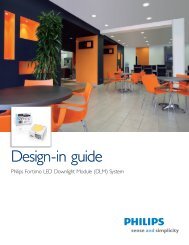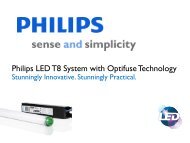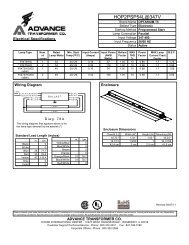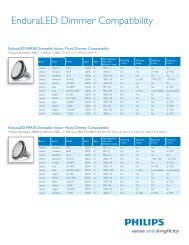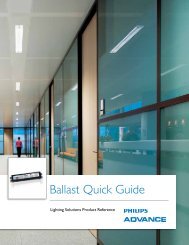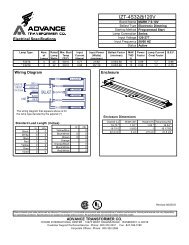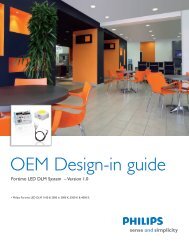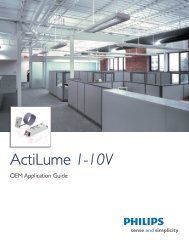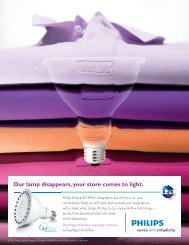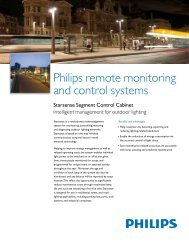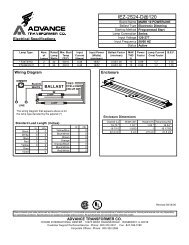Philips QL Induction Lighting Systems - Philips Lighting
Philips QL Induction Lighting Systems - Philips Lighting
Philips QL Induction Lighting Systems - Philips Lighting
- No tags were found...
You also want an ePaper? Increase the reach of your titles
YUMPU automatically turns print PDFs into web optimized ePapers that Google loves.
Thermal radiation can also form a substantial part of the total<br />
heat transfer, and is of the same order as for convection.<br />
This depends strongly on the emission coefficient of the<br />
surface, which lies between 0 and 1. For example, a<br />
polished aluminium surface has a very low emission<br />
coefficient, while that of a painted surface is very high (see<br />
table 5).<br />
Material Finish<br />
Emission<br />
coefficient<br />
New/polished 0.04 ~ 0.06<br />
Aluminium Oxidized 0.2 ~ 0.3<br />
Anodized 0.8<br />
Paint 0.8 ~ 0.95<br />
Copper<br />
New/polished 0.03 ~ 0.07<br />
Heavy oxidized 0.7 ~ 0.8<br />
Table 5: Emission coefficients<br />
Example:<br />
In table 6 and 7 practical information is given on actual<br />
surface area for two different thicknesses of aluminium, for<br />
the same luminaire in "open" and "closed" conditions. For<br />
both luminaire constructions, the recommended maximum<br />
ambient temperatures are given.<br />
Heat sink (aluminium)<br />
Luminaire<br />
Tambient max<br />
thickness surface area<br />
construction<br />
(mm) (cm 2 ) (°C)<br />
Open 2 75 55<br />
Open 1.5 150 55<br />
Closed 2 75 35<br />
Table 6: Typical heat sink design for power coupler of <strong>QL</strong><br />
55W lamp system<br />
Heat sink (aluminium)<br />
Luminaire<br />
Tambient max<br />
thickness surface area<br />
construction<br />
(mm) (cm 2 ) (°C)<br />
Open 2 250 55<br />
Open 1.5 500 55<br />
Closed 2 250 35<br />
Table 7: Typical heat sink design for power coupler of <strong>QL</strong><br />
85W lamp system<br />
2.6 Lamp<br />
Under normal conditions there are no lifetime-determining<br />
parts in the lamp, which means that it can be fully integrated<br />
in the optical housing system. Only the effectiveness of the<br />
fluorescent coating will decrease over time, but at a much<br />
lower rate than with conventional light sources. The light<br />
output after 60,000 hrs will still be more than 70% of the<br />
initial value. See figure 20<br />
conditions the temperature of the mounting flange of the<br />
power coupler reaches the maximum advised temperature.<br />
The measurable difference depends mainly on the luminaire<br />
heat insulation properties, reflector design and construction<br />
of the luminary heat sink. This may result in a light output<br />
difference of maximum 15% over about 70°C/160°F ambient<br />
temperature variation (see figure 12).<br />
2.6.1 PET value<br />
PET stands for Permissible Exposure Time for human<br />
beings in relation to the amount of radiated UV in hours x<br />
1000 lux.<br />
The amount of UV radiated by <strong>QL</strong> 55W and <strong>QL</strong> 85W lamp<br />
systems is about equal to the amount of UV radiated by<br />
conventional low-pressure mercury lamps per 1000 lm, i.e. ><br />
24h x klx.<br />
This means that <strong>QL</strong> lamp systems comply with the generally<br />
accepted value of 24 hours and can be used in open<br />
luminaires, so without any precautions like filters and front<br />
glasses.<br />
2.6.2 Damage factor<br />
Another effect of UV (and blue light) is the risk of fading of<br />
illuminated goods. The fading impact of a light source can be<br />
expressed by the so-called damage factor (Dfc). The total<br />
effect depends on this factor, the total exposure time and the<br />
illumination level.<br />
The damage factor (Dfc) for <strong>QL</strong> 55W and <strong>QL</strong> 85W lamp<br />
systems is



